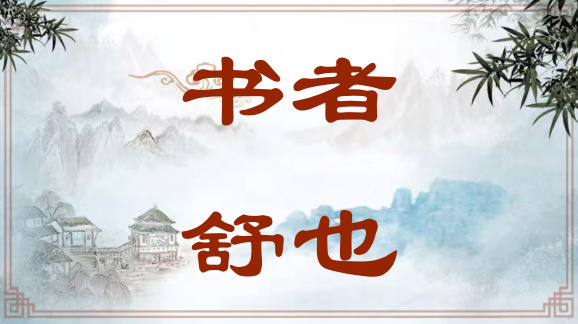Writing Is a Way of Expression

所谓“书(书写)”就是用文字将事情、想法、情感等记录并发布出来。“书”原义指书写,引申指写下来的文字作品。在中国传统语境中,“书”包括一切用文字书写下来的书信、札记、文章、书法作品、图书等。南朝刘勰的《文心雕龙》常从字源出发考察文体的特性与功用。他用前代典籍中“书”字音义同“舒”的解释来说明书写的一般意义:“舒”有展开、呈现、表达等含义,引申指舒展畅快的心理感觉和精神状态。“书”可用来描摹事物、记录感受、表达思想、抒发情感、排遣郁闷等。人都有自我表达的需要,自我的外化可能具有认知、实践、审美等方面的意义,认知、实践意义的实现也会带来审美上的意义。刘勰由此从源头上肯定了一切文体、文学艺术表现手段的根本意义,概括了文章写作、文艺创作的基本功能,并在更广泛的意义上突出强调了文章的审美特点和人的审美需求,标志着文学理论的初步自觉。
To write is to record and release events, ideas, and feelings by means of written words. Shu (书) literally means "to write" and by extension "written works." In the context of traditional Chinese culture, written works include all letters, notes, essays, calligraphic works, and books. In The Literary Mind and the Carving of Dragons, Liu Xie, author active during the Southern Dynasties, frequently takes an etymological approach to examining the features and functions of literary styles. He interprets the general significance of writing by pointing out that according to the classics of previous generations, the characters 书 and 舒 were the same in meaning and pronunciation. As a verb, the character 舒 literally means "to stretch" and by extension "to present" or "to express." As a noun, it takes on the metaphorical meaning of mental relaxation and comfort. Writing, as the character 书 denotes, assumes the roles of depicting things, recording feelings, conveying ideas, expressing emotions, relieving melancholy, and so on. Every person has a clear need for self-expression. The externalization of one's internal state may be meaningful in cognition, practice, and aesthetics, while the realization of such meanings in cognition and practice will result in further aesthetic significance. Starting from the original meanings of the characters, Liu proceeds to affirm the essential significance of all literary styles and means of literary and artistic expressions, summarizes the basic functions of writing and literary and artistic creation, and in a broader sense emphasizes the aesthetic features of writing and the aesthetic need of humanity. His views mark the initial self-awareness of Chinese literary theory.
引例 Citations:
◎上古结绳而治,后世圣人易之以书契,百官以治,万民以察,盖取诸夬(ɡuài)。(《周易·系辞下》)
远古时期人们以结绳记事的方式来治理国家,后世圣人用书契代替结绳,百官用书契裁决政务,万民则通过书契察知事情,这大概是取夬卦的“裁决、决断”之义。
Leaders of primitive times ruled with knotted cords. Sages of later generations replaced them with characters. Officials used characters in governance. The masses of people used them in examining things. This may come from the idea of "judgment" or "decision" suggested in the hexagram of guai. (The Book of Changes)
◎扬雄曰:“言,心声也;书,心画也。声画形,君子小人见矣。”故书者,舒也。舒布其言,陈之简牍,取象于夬,贵在明决而已。(刘勰《文心雕龙·书记》)
扬雄说:“言语是发自内心的声音,文字是表现心意的符号。声音文字将内心表现出来,就能分辨出君子和小人。”所以前人将“书(书写)”解释为“舒(发布、展现)”。将言语、事情记录、呈现在简牍上,这个取象于《周易》的夬卦,夬卦的意义就在于帮助人们明白决断。
Yang Xiong said: "Speech is sounds from the heart, while writings are symbols from the heart. When sounds and symbols take form, a man of virtue can be distinguished from a man of base character." Therefore, writing is a way of expression. The practice of expressing with words and putting them down on bamboo and wooden slips is suggested in the hexagram of guai in The Book of Changes, which stresses the importance of clarity and determination. (Liu Xie: The Literary Mind and the Carving of Dragons)
◎书者,舒也。襟怀舒散,时于清幽明爽之处,纸墨精佳,役者便慧,乘兴一挥,自有潇洒出尘之趣。(费瀛《大书长语·乘兴》)
“书(书法)”是“舒展”的意思。写书法,当在心情舒畅、闲适之时,在清净、幽雅、明亮、气爽之地,用精良上佳的纸墨,身边之人也要反应机敏,这时趁着兴致一挥而就,自然就有潇洒自如、超凡脱俗的意趣。
Calligraphy is a means of expression. A person, with ease and peace of mind, chooses a tranquil, secluded, bright, and clear place for writing. With paper and ink of superior quality and an alert attendant, he makes strokes in high spirits and enjoys the unworldly pleasure of freedom. (Fei Ying: Idle Words on Big Character Calligraphy)
推荐:教育部 国家语委
供稿:北京外国语大学 外语教学与研究出版社
责任编辑:钱耐安





